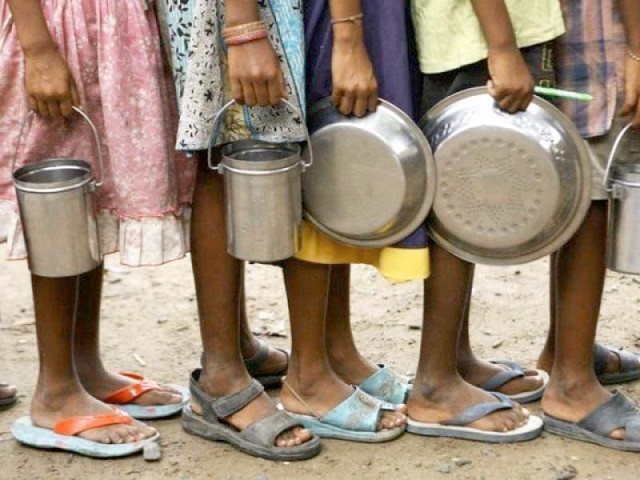Floods push 9m people into poverty
World Bank believes poverty rate can increase by 2.5 to 4 percentage points

The World Bank has drastically lowered its estimate of the impact of floods on poverty and released a new figure, saying that up to nine million more people may have slipped into poverty due to the climatic consequences, which has taken the poverty level to over 40% of the population.
In its Pakistan Development Update, the World Bank cautioned that vulnerable people would take years to recover from the impact of the devastating floods and high inflation. Despite a reduction in the poverty estimate, still 40% of the population, or 89 million, will be living in poor conditions.
“Preliminary estimates suggest that as a direct consequence of the floods, the national poverty rate can increase further by 2.5 to 4 percentage points, pushing between 5.8 million and 9 million people into poverty,” said the World Bank report that was launched on Thursday.
Earlier, the bank had told the government that the national poverty rate could further increase in the range of 4.5% to 7%, which would envelop another 9.9 million and 15.4 million people. The fresh number is lower by 4.1 million to 6.4 million.
It is a quickly evolving situation and in light of the latest information, the World Bank has revised downward the poverty estimate, said the bank’s economist Moritz Meyer. Meyer said that the inflationary pressures were likely to continue in the context of recent floods, which were expected to disrupt the supply of critical household and agricultural goods, disproportionately impacting the most vulnerable people.
Reversing these negative socio-economic effects is likely to take considerable time and some losses, such as human capital and land productivity. These can lead to a more sustained decline in welfare and will warrant specific policy attention, according to the report.
The World Bank has also revised the international poverty line by adjusting the purchasing power parity. The extreme poverty measure has been adjusted from $1.9 to $2.15 per day.
Read EU holds debate on humanitarian crises in flood-hit Pakistan
Higher poverty lines typically used to measure poverty in the lower middle-income countries have been updated from $3.20 to $3.65 per day. Due to high GDP growth in Pakistan, the projected poverty headcount, measured at the lower middle-income class line of $3.65 per day, has decreased from 39.1% in fiscal year 2020-21 to 36.4% in the last fiscal year.
The World Bank has described the recent floods as the “most severe since independence”, saying that these have further exacerbated inflationary pressures.
Due to the consequences of floods, agricultural output is expected to be negatively impacted as rising inflation has reduced the real purchasing power of households, with adverse welfare implications, especially for the poor and vulnerable. Based on a phone survey, the World Bank observed that economic hardship remained high in Pakistan, with over half of respondents having concerns about running out of food in the next week, and 44% of households, who are struggling to pay rent.
The survey also showed a decrease in school enrolment rates, as parents could no longer afford school fees. Meyer said that over the past year, inflation in Pakistan rose rapidly, breaking from past trends as higher food and energy prices underpinned the increase in inflation.
Quickly rising prices and their high volatility impact firms and households. During times of quickly rising food prices, the poorer households experienced higher inflation rates, the report stated. Similarly, due to the differences in consumption patterns, relatively poorer households have been more exposed to food inflation, whereas better-off households have been more exposed to energy inflation, according to the report.
The poorer households tend to have fewer savings to mitigate the impact of rising prices, which often forces them to cut back on the level of consumption or to substitute for lower-quality products. Over the medium term, this may have a detrimental impact on the human development outcomes.
“Pakistan should undertake those sectoral policies that benefit poor, including trade policies to reduce prices,” Meyer suggested.
Read more Flood devastated government schools face uncertain future
However, the lender has paddled an interesting set of recommendations to contain inflation, which in fact may increase poverty, unemployment and inflation.
It argued that Pakistan should maintain macroeconomic policies that contained inflationary pressures, while also advocating for “maintaining the independence of State Bank, combined with proactive and data-driven monetary policymaking to support price stability objectives.”
It also recommended to sustain overall fiscal discipline to prevent excessive aggregated demand pressures that drive up prices. It stressed the need to avoid measures that impose unsustainable fiscal costs and largely benefit households with higher incomes.
The World Bank also supported further increase in electricity prices, by “maintaining progress with the removal of energy price relief measures”.
Published in The Express Tribune, October 7th, 2022.
Like Business on Facebook, follow @TribuneBiz on Twitter to stay informed and join in the conversation.



















COMMENTS
Comments are moderated and generally will be posted if they are on-topic and not abusive.
For more information, please see our Comments FAQ